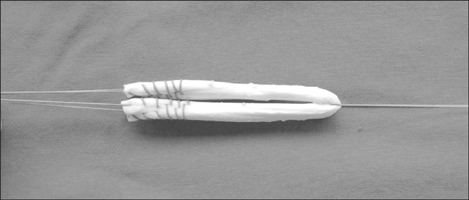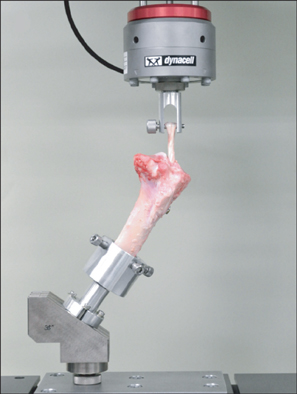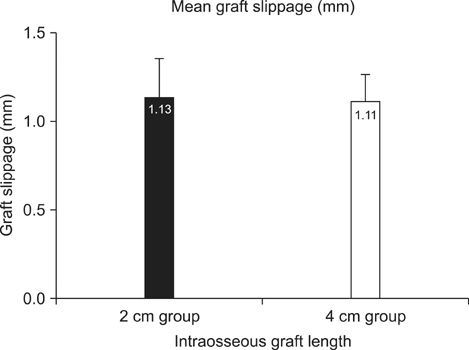Clin Orthop Surg.
2014 Jun;6(2):173-179. 10.4055/cios.2014.6.2.173.
A Comparison of the Fixation Strengths Provided by Different Intraosseous Tendon Lengths during Anterior Cruciate Ligament Reconstruction: A Biomechanical Study in a Porcine Tibial Model
- Affiliations
-
- 1Madipyunhan Orthopedic Clinic, Daegu, Korea.
- 2Park's Orthopedic Hospital, Daegu, Korea.
- 3Department of Orthopaedic Surgery, Kyungpook National University School of Medicine, Daegu, Korea. hskyung@knu.ac.kr
- KMID: 1784663
- DOI: http://doi.org/10.4055/cios.2014.6.2.173
Abstract
- BACKGROUND
The purpose of this study was to determine the tibial fixation strength provided by different intraosseous soft tissue graft lengths within the tibial tunnel.
METHODS
Porcine tibial bones and digital flexor tendons were used for testing. Bone mineral densities of proximal tibial medial condyles were measured, and two-strand tendon bundles of 8 mm diameter were used. An intraosseous graft length of 2 cm was used in group 1 (n = 10), and a graft length of 4 cm was used in group 2 (n = 10). Tunnels were 4 cm in length and 8 mm in diameter. Tibial fixation was performed using a suture tied around a screw post with a washer and an additionally inserted 7 x 20 mm bioabsorbable screw. After applying preconditioning loading of 10 cycles, 1,000 cycles between 70-220 N were applied at a frequency of 1 Hz. Graft slippage and total graft movement were recorded. Ultimate tensile strength was measured by pull-out testing at an Instron crosshead speed of 1,000 mm/min.
RESULTS
No significant intergroup difference was found for total graft movement after cyclic loading (slippage in group 1, 1.2 mm and group 2, 1.2 mm, respectively, p = 0.917; and total graft movement in group 1, 3.3 mm and group 2, 2.7 mm, respectively, p = 0.199). However, mean ultimate tensile strength in group 2 was significantly higher than that in group 1 (group 1, 649.9 N; group 2, 938 N; p = 0.008).
CONCLUSIONS
In a porcine model, ultimate tensile strength was greater for a 4 cm long intraosseous flexor tendon in the tibial tunnel. However, no intergroup difference in graft slippage or total graft movement was observed. The results show that a 2 cm intraosseous graft length in the tibial tunnel is safe and has sufficient strength (> 450 N) for adequate rehabilitation after anterior cruciate ligament reconstruction.
Keyword
MeSH Terms
Figure
Cited by 1 articles
-
Mid-Term Results after Anterior Cruciate Ligament Reconstruction Using Four-Strand Single Semitendinosus Tendon
Ho-Won Park, Hee-June Kim, Hee-Soo Kyung, Jung-Won Han
J Korean Orthop Assoc. 2015;50(5):387-393. doi: 10.4055/jkoa.2015.50.5.387.
Reference
-
1. Pinczewski L, Roe J, Salmon L. Why autologous hamstring tendon reconstruction should now be considered the gold standard for anterior cruciate ligament reconstruction in athletes. Br J Sports Med. 2009; 43(5):325–327.2. Rodeo SA, Arnoczky SP, Torzilli PA, Hidaka C, Warren RF. Tendon-healing in a bone tunnel: a biomechanical and histological study in the dog. J Bone Joint Surg Am. 1993; 75(12):1795–1803.3. Noyes FR, Butler DL, Paulos LE, Grood ES. Intra-articular cruciate reconstruction. I: Perspectives on graft strength, vascularization, and immediate motion after replacement. Clin Orthop Relat Res. 1983; (172):71–77.4. Noyes FR, Grood ES. The strength of the anterior cruciate ligament in humans and Rhesus monkeys. J Bone Joint Surg Am. 1976; 58(8):1074–1082.5. Noyes FR, Keller CS, Grood ES, Butler DL. Advances in the understanding of knee ligament injury, repair, and rehabilitation. Med Sci Sports Exerc. 1984; 16(5):427–443.6. Salmon L, Pinczewski L, Roe J. The science of rehabilitation of the ACL injured and reconstructed knee. J Sci Med Sport. 2009; 12:Suppl. S59–S60.7. Shelbourne KD, Klotz C. What I have learned about the ACL: utilizing a progressive rehabilitation scheme to achieve total knee symmetry after anterior cruciate ligament reconstruction. J Orthop Sci. 2006; 11(3):318–325.8. Zantop T, Ferretti M, Bell KM, Brucker PU, Gilbertson L, Fu FH. Effect of tunnel-graft length on the biomechanics of anterior cruciate ligament-reconstructed knees: intra-articular study in a goat model. Am J Sports Med. 2008; 36(11):2158–2166.9. Yamazaki S, Yasuda K, Tomita F, Minami A, Tohyama H. The effect of intraosseous graft length on tendon-bone healing in anterior cruciate ligament reconstruction using flexor tendon. Knee Surg Sports Traumatol Arthrosc. 2006; 14(11):1086–1093.10. Qi L, Chang C, Jian L, Xin T, Gang Z. Effect of varying the length of soft-tissue grafts in the tibial tunnel in a canine anterior cruciate ligament reconstruction model. Arthroscopy. 2011; 27(6):825–833.11. Kyung HS, Kim TG, Oh CW, Yoon SH. Anterior cruciate ligament reconstruction with a four-strand single semitendinosus tendon autograft. J Korean Arthrosc Soc. 2009; 13(2):138–142.12. Herrera A, Martinez F, Iglesias D, Cegonino J, Ibarz E, Gracia L. Fixation strength of biocomposite wedge interference screw in ACL reconstruction: effect of screw length and tunnel/screw ratio: a controlled laboratory study. BMC Musculoskelet Disord. 2010; 11:139.13. Nagarkatti DG, McKeon BP, Donahue BS, Fulkerson JP. Mechanical evaluation of a soft tissue interference screw in free tendon anterior cruciate ligament graft fixation. Am J Sports Med. 2001; 29(1):67–71.14. Coleridge SD, Amis AA. A comparison of five tibial-fixation systems in hamstring-graft anterior cruciate ligament reconstruction. Knee Surg Sports Traumatol Arthrosc. 2004; 12(5):391–397.15. Halewood C, Hirschmann MT, Newman S, Hleihil J, Chaimski G, Amis AA. The fixation strength of a novel ACL soft-tissue graft fixation device compared with conventional interference screws: a biomechanical study in vitro. Knee Surg Sports Traumatol Arthrosc. 2011; 19(4):559–567.16. Fleming BC, Magarian EM, Harrison SL, Paller DJ, Murray MM. Collagen scaffold supplementation does not improve the functional properties of the repaired anterior cruciate ligament. J Orthop Res. 2010; 28(6):703–709.17. Murray MM, Magarian EM, Harrison SL, Mastrangelo AN, Zurakowski D, Fleming BC. The effect of skeletal maturity on functional healing of the anterior cruciate ligament. J Bone Joint Surg Am. 2010; 92(11):2039–2049.18. Seil R, Rupp S, Krauss PW, Benz A, Kohn DM. Comparison of initial fixation strength between biodegradable and metallic interference screws and a press-fit fixation technique in a porcine model. Am J Sports Med. 1998; 26(6):815–819.19. Tetsumura S, Fujita A, Nakajima M, Abe M. Biomechanical comparison of different fixation methods on the tibial side in anterior cruciate ligament reconstruction: a biomechanical study in porcine tibial bone. J Orthop Sci. 2006; 11(3):278–282.20. Greis PE, Burks RT, Bachus K, Luker MG. The influence of tendon length and fit on the strength of a tendon-bone tunnel complex: a biomechanical and histologic study in the dog. Am J Sports Med. 2001; 29(4):493–497.21. Gobbi A, Domzalski M, Pascual J, Zanazzo M. Hamstring anterior cruciate ligament reconstruction: is it necessary to sacrifice the gracilis? Arthroscopy. 2005; 21(3):275–280.22. Kyung HS, Oh CW, Lee HJ. Clinical evaluation of anterior cruciate ligament reconstruction with remnant-preserving technique: method using single four-strand semitendinosus tendon. J Korean Orthop Assoc. 2011; 46(1):60–67.23. Streich NA, Friedrich K, Gotterbarm T, Schmitt H. Reconstruction of the ACL with a semitendinosus tendon graft: a prospective randomized single blinded comparison of double-bundle versus single-bundle technique in male athletes. Knee Surg Sports Traumatol Arthrosc. 2008; 16(3):232–238.24. Zamarra G, Fisher MB, Woo SL, Cerulli G. Biomechanical evaluation of using one hamstrings tendon for ACL reconstruction: a human cadaveric study. Knee Surg Sports Traumatol Arthrosc. 2010; 18(1):11–19.25. Paschal SO, Seemann MD, Ashman RB, Allard RN, Montgomery JB. Interference fixation versus postfixation of bone-patellar tendon-bone grafts for anterior cruciate ligament reconstruction: a biomechanical comparative study in porcine knees. Clin Orthop Relat Res. 1994; (300):281–287.26. Donahue TL, Gregersen C, Hull ML, Howell SM. Comparison of viscoelastic, structural, and material properties of double-looped anterior cruciate ligament grafts made from bovine digital extensor and human hamstring tendons. J Biomech Eng. 2001; 123(2):162–169.27. Morrison JB. The mechanics of the knee joint in relation to normal walking. J Biomech. 1970; 3(1):51–61.
- Full Text Links
- Actions
-
Cited
- CITED
-
- Close
- Share
- Similar articles
-
- A Biomechanical Study of Graft Fixation in Posterior Cruciate Ligament Reconstruction
- The Effect of Cyclic Tensile Load on Various Tibial Fixation Techniques in Anterior Cruciate Ligament Reconstruction
- Optimal Parameters for Sutures Tied to a Post during Anterior Cruciate Ligament Reconstruction: Thread Numbers, Knot Numbers, Suture Techniques and Stitch Numbers: An Experimental Laboratory Study Using Porcine Tendon
- Reconstruction of Posterior Cruciate Ligament Using Semitendinosus Tendon (3 cases)
- Comparison of Bioabsorbable Suture Anchor Fixation on the Tibial Side for Anterior Cruciate Ligament Reconstruction Using Free Soft Tissue Graft: Experimental Laboratory Study on Porcine Bone






